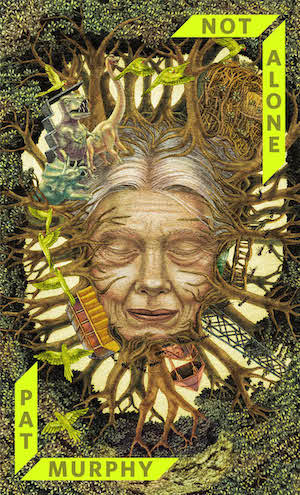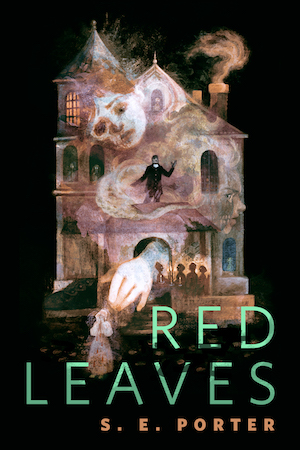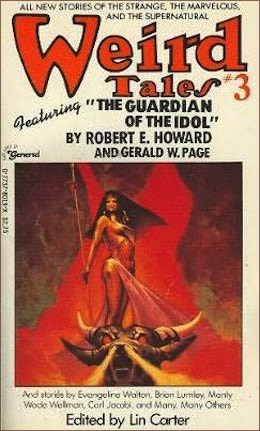Welcome back to the Lovecraft reread, in which two modern Mythos writers get girl cooties all over old Howard’s sandbox, from those who inspired him to those who were inspired in turn.
Today we’re looking at Lin Carter’s “The Winfield Heritance” (unless it’s “Heritage” or “Inheritance,” sources differ), first published in 1981 in Weird Tales #3 (an anthology, edited by Carter himself, not a magazine). Spoilers ahead.
“The coiling stone stair did not end, but it vanished into a black pool of slimy liquid mud which completely filled the bottom of the stairwell. Something died within me as I shone my light across that black pool.”
Summary
Here we have the written statement of Winfield Phillips, once secretary to Dr. Seneca Lapham of Miskatonic University, now independently wealthy thanks to his inheritance from maternal uncle Hiram Stokely. Hiram was born Winfield, but the Winfields so ostracized him that he rejected their name. Supposedly he practiced forbidden practices and read books which should not be read. Be that as it may, he moved from Arkham to California, where he made his fortune and built a mansion near Durnham Beach.
At twenty-nine, Winfield considers himself sound of mind and body, but he’s unsure about his soul. Should you find his statement, please send it to Dr. Lapham. Oh, and for your own sanity, you’d better not read it first. (Too late, sorry.)
When Hiram died, Winfield expected no bequest; after all, he’d never even met his uncle. He attended the funeral to represent the family, to follow up on Dr. Lapham’s research interests at the Sanbourne Institute of Pacific Antiquities, and to meet his favorite cousin Brian. To Winfield’s surprise, Brian says they’ve inherited Hiram’s mansion and its contents.
After the funeral they drive to Durnham Beach. Brian’s been helping Winfield investigate the Ponape Figurine and its discoverer Professor Copeland, who died insane. Well, guess what? Copeland got certain Mythosian tomes from Uncle Hiram, a great collector of such rare books. Winfield’s astounded. Was Hiram an occultist, a student of “Alhazredic demonology?” But all Brian knows is Winfield will now have his pick of Hiram’s books.
Durnham Beach inspires “uneasy depression” with its stagnant mud-flats, moldering storefronts and sullen residents. The very sunlight seems dim. Yeah, Brian says, the place has gone downhill since the Hubble’s Field atrocity was discovered. Doesn’t Winfield remember how the county was digging for a pipeline and found the dismembered remains of hundreds of people, from contemporary times back to the days of the Hippaway nation. No wonder the Hippaway called Hubble’s Field “the place of worms.”
In fact, Hiram’s rambling stucco house sits right next to Hubble’s Field, which won’t boost its resale value. Ditto the neglected grounds and dusty, musty interior. The furniture and bric-a-brac look valuable, though, and that unsavory picture by Richard Pickman on the library wall. The books are mostly standard classics, but Winfield discovers one shelf with a row of books concealed behind the “embalmed masterpieces.” These include such rare works of decadent literature as Derby’s Azathoth and Other Horrors, Geoffrey’s People of the Monolith, and Carson’s unpublished manuscript of Black God of Madness! There’s a magazine with Randolph Carter’s infamous story, “The Attic Window,” and another unpublished manuscript of Robert Blake’s last five stories. Huh, Brian says. If these things were so fabulous, why didn’t Hiram display them proudly? Winfield has no answer.
Next day Brian’s rooting for more hidden books when he finds a secret door into a small chamber. It contains an authentic medieval adumbry, a case for the flat storage of books too big to stand on edge. And the adumbry holds? What else but moldering tomes, like Dr. Dee’s English translation of the Necronomicon and Gaspard du Nord’s Book of Eibon, both in manuscript! Cryptic instruments crowd the top shelf; chalked cabalistic diagrams are traced on the floor. Winfield’s stomach turns as he realizes why his family broke off relations with Hiram—his uncle had been dabbling in lore too blasphemous for toleration!
After a dinner in town, where the residents glare and mumble “Now it’s gonna start all over again,” the cousins return to the mansion. Winfield starts cataloguing its contents. Brian delves into Dee’s Necronomicon. He calls Winfield over to share a passage about Zoth-Ommog, the supposed subject of the Ponape Figurine. Ubb, Father of Worms, leads Zoth-Ommog’s servitors, which slither in fetid burrows under the earth. These so-called Yuggs strive to free their Master, long imprisoned by the Elder Sign. They corrupt men with a thirst for knowledge or wealth or power by whispering evil promises to them in the night.
Could Ubb—think Hubble’s Field—be the source of Uncle Hiram’s never-explained fortune? Winfield flinches from the idea. Brian’s determined to plumb the mystery He rushes back to the secret room, Winfield following. Behind the adumbry, they find yet another secret: rough-hewn stone steps leading down into darkness. Descending, the two tread over gold coins and precious gems. Brian kicks the ill-got treasure aside. Below something stirs.
Brian rushes down to confront it. Stench rises to choke Winfield. He glimpses something “huge and wet and glistening white.” Then Brian screams, “a raw shriek of ultimate horror.” Winfield stumbles to his aid but finds nothing except a black pool of mud into which the steps vanish. The pool ripples as if something’s just fallen in, or been dragged.
Winfield reports Brian’s disappearance to the police, who apparently dismiss his statement as lunatic raving. For obscure reasons, he remains in Brian’s apartment instead of returning to work in Arkham.
Or maybe the reasons aren’t so obscure. Every night Voices whisper to Winfield. Now that he’s performed the Red Offering, aka Brian, he may make the Sign of Koth and enter the Dream-Gates, eventually flying via Byakhee bird even unto Carcosa by Lake Hali, there to meet the King in Yellow Himself!
Of course, more Red Offerings will be required…
Winfield spends his days reading the Necronomicon, passing time until the return of night and the Voices. Maybe he’ll move into Hiram’s house in Durnham Beach. After all it belongs to him now, part of the Winfield heritance.
What’s Cyclopean: “Slatternly” is the unfortunate word of the day, used repeatedly to describe the women of Durnham Beach.
The Degenerate Dutch: What is it with dying industrial towns and eldritch abominations, anyway?
Mythos Making: A giant pile of eldritch tomes is a good excuse to mention every unpronounceable name ever created by pounding randomly on a typewriter. Along with the full pantheon of Cthulhu’s second cousins once removed, there are Mi-Go and Dholes and nightgaunts, oh my.
Libronomicon: Uncle Hiram’s collection is far too long to detail here. Highlights include the rare-as-lawful-good-drow Necronomicon, a first edition Book of Eibon, Unspeakable Cults, Edward Pickman Derby’s poetry collection, and a little something by an obscure author named Phillip Howard.
Madness Takes Its Toll: The Ponape Figurine drove two famous scientists mad. Poet Ariel Prescott died in a madhouse. A student at Midwestern university went insane after reading Phillip Howard’s House of the Worm. It seems weird fiction is at least as likely to require sanity rolls as the Necronomicon itself—doesn’t seem right.
Anne’s Commentary
Huh. No wonder I was confused by a lot of the references dropped in this story. A little research (sometimes, yes, a dangerous thing) reveals that “The Winfield Heritance” is the last of five Lin Carter stories comprising the so-called Xothic Legend Cycle. All concern Cthulhu’s sons, those obnoxious brats Ghatanathoa, Ythogtha and Zoth-Ommog. The first three stories introduce the Ponape Figurine, a psychoactive rendering of Zoth-Ommog; they also introduce Professor Harold Hadley Copeland and Henry Stephenson Blaine of the Sanbourne Institute, both of whom are driven mad, quite mad, by the statuette. Luckily one of those Elder Sign “star-stones,” lobbed by an assistant of Blaine’s, destroys the deadly artifact, along with a Deep One trying to abscond with it. Because you know how Deep Ones are. They can’t hold their star-stones, at least not in those later Mythosian tales that render Elder Sign knick-knacks a panacea against all naughty Mythos creatures. Like crosses to vampires or silver to werewolves. Ah, if only it were that easy.
Zoth-Ommog Himself sounds like a hybrid of the Yith (cone body), the Elder Things (starfish arms), daddy Cthulhu (the mane of tentacles) and Serpent People (the reptilian head.) No wonder His image is so confuddling to the mere human brain.
Winfield Phillips briefly mentions an adventure with mentor Seneca Lapham that prepared him for the eldritch horrors described in Hiram’s tomes. This adventure is detailed in Derleth’s Lurker on the Threshold, called a collaboration with Lovecraft but mostly Derleth’s work. Lurker‘s my favorite Derleth, by the way, all Yog-Sothothy as it is. We really ought to tackle it one of these days, nudge nudge, wink wink to my co-conspirator.
You’d think after what Winfield saw in Billington’s Wood that he wouldn’t act so no-no-it-can’t-be! about Uncle Hiram’s collaboration with Ubb and the Yuggs (yet another great Lovecraftian band name.) Because what’s a Yugg to Yog (Sothoth, that is)?
Lots of well-worn Mythosian tropes here, like Hiram’s collection of incredibly rare books. In fact, Hiram outdoes most collectors of the arcane by possessing actual manuscript copies of the Dee Necronomicon and the Book of Eibon! In their authors’ own hands! Those must have come directly from Ubb’s personal library. Then there’s the room hidden behind a bookcase, the deteriorating manse, the melodramatic dialogue (Great Scott! My God!), the surly and suspicious townspeople, the Native Americans canny enough to avoid the Bad Place, and the slimy steps spiraling to unknown depths under the earth. More interestingly handled tropes, for me, were the poisoned atmosphere hanging over Durnham Beach and the dangerous inheritance.
Once again we see that core Lovecraft idea that the past can throttle the present with the iron grip of inheritance. Not of the property sort but of the blood, of family curses or proclivities or weaknesses. Winfield Phillips may never have met his uncle, favorite brother of his mother, but he resembles Hiram in his attraction to the outré, first expressed (with relative harmlessness) in his interest in decadent literature. Less harmless is the interest in things Mythosian implied by his staying on as Seneca Lapham’s assistant after graduation from Miskatonic. Downright damning is the ease with which he’s seduced by the Voices of the Yuggs, even after witnessing his cousin taken as their sacrifice. When he finally decides to claim his heritance by moving in to Hiram’s house, can the reader doubt he means also to take Hiram’s place as Yugg ally?
Treacherous allies, I fear, the worms. Let’s not forget that Hiram has a closed-casket funeral. I guess his corpse wasn’t pretty, as corpses much gnawed and fretted rarely are. Unless you’re a ghoul, of course, nearly as pallid and burrowing as the Yuggs themselves.
I wonder if ghouls and Yuggs ever meet underground, you know, to throw a neighborly block party or exchange recipes over the barbeque grill. Subterranean potluck, anyone?
Ruthanna’s Commentary
We’ve talked before about the ideal level of Mythos reference in a Mythos story. For once, I’m not hugely picky. I’ve enjoyed stories that were all awesome new creepiness, and others that flung shout-outs with joyful abandon. But “Winfield Heritance” exceeds even my patience on this front—it’s so deep in shout-outs that there’s very little there there.
Not that the shout-outs aren’t fun. About half the central Mythosian canon gets at least a passing reference, even when Carter’s characters have to lose their place in the Necronomicon to manage a Mi-Go mention. Chambers and Carcosa get a moment as well, along with Derleth—rather too much Derleth, with his comprehensibly dualistic cosmos and powerful elder signs. Our narrator has even had a previous adventure, dealing with a Deep One artifact from Ponape (apparently a previous Carter tale, the reading of which might have provided me with a little more front-end plot to balance this one).
But few of the references have much relevance to the actual story. Strip them away, and that story is awfully thin. Boy brings cousin to dead uncle’s house. Boy learns that dead uncle was an avid collector of eldritch tomes. Boy learns that dead uncle was an avid sacrificer to giant white worms. Cousin gets et. Boy takes up family business. Put that way, it doesn’t actually sound that thin. Maybe if it weren’t padded with irrelevant elder gods, it would have the power it deserves.
Because there is so much potential creepiness in the worms’ pitch. Since you already have… you might as well… After all, his cousin is one of his dearest friends, only in the house in the first place for a much-awaited reunion. And only interested in the musty tomes because Narrator has some idea what’s in them. Really, it’s all your fault, and wouldn’t you rather have done it on purpose?
Then there’s the old Lovecraftian trope of the taint in the blood. Well-trodden, yet it can still be effective when it’s done right. Learning of familial crimes can be unnerving for anyone, after all—and realistically, most families with any historical memory have a few nasty skeletons to leave their scions. Most readers will feel a twinge of empathy, even if their own line traces to a slave owner or horse thief rather than a neighbor-sacrificing sorcerer. Blood money comes in many forms, after all.
Plenty of Lovecraft’s narrators succumb to the inevitable call of their familial destiny. It does seem slightly strange in our narrator’s case. “And I am a Winfield.” Yes, and you just finished talking about how most of the family was better known for disowning your Necronomicon-loving uncle. This isn’t exactly a long line of degeneracy or the one drop of Deep One blood that it takes to return to the water. It’s the black sheep of the family, and not even your direct ancestor. Is this already the whisper of the worms, or just angst?
And if, at the end, he falls prey to temptation, then why is he writing all this down and sending it to his old boss, anyway? Is he trying to get caught?
And what is it with worms, anyway? Tempting men to sacrifice with vast wealth here, stealing mage-souls there, even causing earthquakes when you run off with their babies. (I’m willing to let Cthonians be honorary worms, under the circumstances.) Real life worms may be slimy and squirmy and have creepy regeneration powers, but are mostly busy making soil. They don’t deserve the bad rap they get from weird fiction.
We’re taking next week off, because Wiscon. If you happen to be in Madison, come to our reading at Michelangelo’s on Saturday afternoon, then join us for the Lovecraftian Girl Cooties party on Saturday night! Then in two weeks we’ll be back here for Cosmic Horror IN SPAAAAACE with Elizabeth Bear and Sarah Monette’s “Boojum.”
Ruthanna Emrys’s neo-Lovecraftian stories “The Litany of Earth” and “Those Who Watch” are available on Tor.com, along with the distinctly non-Lovecraftian “Seven Commentaries on an Imperfect Land” and “The Deepest Rift.” Winter Tide, a novel continuing Aphra Marsh’s story from “Litany,” is now available from Macmillan’s Tor.com imprint. Ruthanna can frequently be found online on Twitter and Dreamwidth, and offline in a mysterious manor house with her large, chaotic household—mostly mammalian—outside Washington DC.
Anne M. Pillsworth’s short story. “The Madonna of the Abattoir” appears on Tor.com. Her young adult Mythos novel, Summoned, is available from Tor Teen along with sequel Fathomless. She lives in Edgewood, a Victorian trolley car suburb of Providence, Rhode Island, uncomfortably near Joseph Curwen’s underground laboratory.










